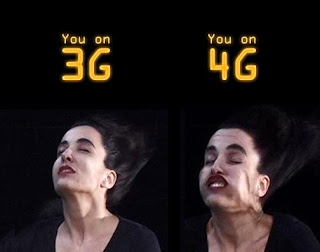3G and 4G
What is 4G?
The term 4G refers to the fourth generation of
cellular networks which will support IP packet
switching. As of December 2010, no current
technologies meet the International
Telecommunications Union (ITU) standard. ITU Standard The ITU set the standard for 4G networks in
October 2010 stating that the peak download speed
of a 4G network must be 100 megabits per second
(Mbps) for devices like mobile phones and up to 1
gigabit per second (Gbps) for local wireless access.
What Are the Advantages of Using 4G?
As of November 2010, Worldwide Interoperability for Microwave Access (WiMAX) and 3GPP Long Term Evolution (LTE) are marketed as 4G networks and are considered by the International Telecommunications Union (ITU) as candidate technologies for 4G. High Speed Packet Access (HSPA+) networks are also marketed in the US as a 4G network though it is not recognized by the ITU. Pure Data Network The current 3G mobile network handle both voice and data separately. One of the most significant changes to the 4G network is that is a data network, transferring Internet Protocol (IP) data packets. A completely data based network will allow for more bandwidth which means more data can be passed through the network. Speed In October 2010, the ITU set the standard for 4G networks to have a peak data download speed of 100 Megabits per second (Mbps) in mobile applications such as mobile phones and roaming network devices and 1 Gigabit per second (Gbps) in local, fixed locations. As of November 2010, no network technology can claim that it meets these standards though all the networks currently marketed as 4G do surpass current 3G speeds which tops out at 1 Mbps. The current WiMAX 802.16 standard, used mostly by Sprint and ClearMobile, has a current top speed of 3.0 Mbps while LTE has a theoretical maximum top speed of 12 Mbps. Range Current 3G network technology range is approximately 10 miles under optimum conditions. 4G candidate WiMAX currently has a range of up to 31 miles under optimum conditions. Hand Off Though current 3G networks do have the ability to transfer data, when a user leaves a 3G coverage area for another, the data transfer may be halted or stopped due compatibility issues. The improved 4G network standards will eliminate this, allowing for smooth hand off from one coverage area to another without interruption to any ongoing data transfers. This will result in smooth streaming data for the user.What's the Difference Between 3G & 4G?
3G is currently the world’s best connection method when it comes to mobile phones, and especially mobile Internet. 3G stands for 3rd generation as it is just that in terms of the evolutionary path of the mobile phone industry. 4G means 4th generation. This is a set of standard that is being developed as a future successor of 3G in the very near future. The biggest difference between the two is in the existence of compliant technologies. There are a bunch of technologies that fall under 3G, including WCDMA, EV-DO, and HSPA among others. Although a lot of mobile phone companies are quick to dub their technologies as 4G, such as LTE, WiMax, and UMB, none of these are actually compliant to the specifications set forth by the 4G standard. These technologies are often referred to as Pre-4G or 3.9G. 4G speeds are meant to exceed that of 3G. Current 3G speeds are topped out at 14Mbps downlink and 5.8Mbps uplink. To be able to qualify as a 4G technology, speeds of up to 100Mbps must be reached for a moving user and 1Gbps for a stationary user. So far, these speeds are only reachable with wired LANs. Another key change in 4G is the abandonment of circuit switching. 3G technologies use a hybrid of circuit switching and packet switching. Circuit switching is a very old technology that has been used in telephone systems for a very long time. The downside to this technology is that it ties up the resource for as long as the connection is kept up. Packet switching is a technology that is very prevalent in computer networks but has since appeared in mobile phones as well. With packet switching, resources are only used when there is information to be sent across. The efficiency of packet switching allows the mobile phone company to squeeze more conversations into the same bandwidth. 4G technologies would no longer utilize circuit switching even for voice calls and video calls. All information that is passed around would be packet switched to enhance efficiency.
Summary:3G & 4G
1. 3G stands for 3rd generation while 4G stands for 4th generation2. 3G technologies are in widespread use while 4G compliant technologies are still in the horizon
3. 4G speeds are much faster compared to 3G
4. 3G is a mix of circuit and packet switching network while 4G is only a packet switching network.







Amazing Info
ReplyDeleteThanks Mr.Talha
ReplyDeleteNicely written article.
ReplyDelete